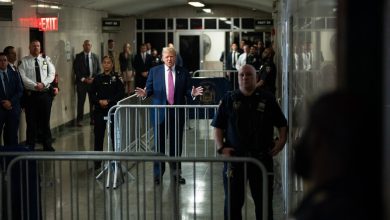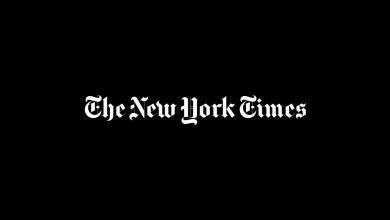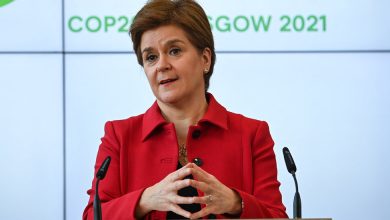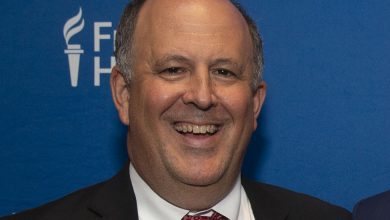Her Majesty’s Last Broadcast

Television introduced Queen Elizabeth II to the world. It was only fitting that television should see her out of it.
The queen’s seven-decade reign almost exactly spanned the modern TV era. Her coronation in 1953 began the age of global video spectacles. Her funeral on Monday was a full-color pageant accessible to billions.
It was a final display of the force of two institutions: the concentrated grandeur of the British monarchy and the power amassed by television to bring viewers to every corner of the world.
“I have to be seen to be believed,” Elizabeth once reportedly said. It was less a boast than an acknowledgment of a modern duty. One had to be seen, whether one liked it or not. It was her source of authority at a time when the crown’s power no longer came through fleets of ships. It was how she provided her country reassurance and projected stability.
The last funeral service for a British monarch, King George VI, was not televised. For one last time, Elizabeth was the first. She entered the world stage, through the new magic of broadcasting, as a resolute young face. She departed it as a bejeweled crown on a purple cushion, transmuted finally into pure visual symbol.
Americans who woke up early Monday (or stayed up, in some time zones) saw striking images aplenty, on every news network. The breathtaking God’s-eye view from above the coffin in Westminster Abbey. The continuous stream of world leaders. The thick crowds along the procession to Windsor, flinging flowers at the motorcade. The corgis.
Viewers also saw and heard something unusual in the TV news environment: long stretches of unnarrated live action — the speaking of prayers, the clop of horse hooves — and moments of stillness. This was notable in the golf-whisper coverage on BBC World News, which let scenes like the loading of the coffin onto a gun carriage play out in silence, its screen bare of the usual lower-thirds captions.
The commercial American networks, being the distant relations at this service, filled in the gaps with chattery bits of history and analysis. News departments called in the Brits. (On Fox News, the reality-TV fixtures Piers Morgan and Sharon Osbourne critiqued Prince Harry and Meghan Markle’s media ventures.) “Royal commentators” broke down points of protocol and inventoried the materials and symbolism of the crown, scepter and orb like auction appraisers.
But even American TV fell still during the funeral ceremony. The cameras drank in the Gothic arches of Westminster Abbey, bathed in the hymns of the choirs, goggled at the royal jewels, lingered on the solemn face of Charles III during the performance of — it still sounds strange — “God Save the King.” Finally, we watched from above as bearers carried the coffin step by step across the black-and-white-diamond floor like an ornate chess piece.
The quiet spectating was a gesture of respect but also a kind of tourist’s awe. We had come all this way; of course we wanted to take in the sights.
Elizabeth’s reign was marked by unprecedented visibility, for better or worse. Her coronation in 1953 spurred the British to buy television sets, bringing the country into the TV age and inviting the public into an event once reserved for the upper crust.
This changed something essential in the relation of the masses to the monarchy. The coronation, with its vestments and blessings, signified the exclusive connection of the monarch to God. Once that was no longer exclusive, everything else in the relationship between the ruler and the public was up for negotiation.
The young queen resisted letting in the cameras. The prime minister Winston Churchill worried about making the ritual into a “theatrical performance.” But Elizabeth could no more stop the force of media than her forebear King Canute could halt the tide.
TV undercut the mystique of royalty but spread its image, expanding the queen’s virtual reach even as the colonial empire diminished. There were other surviving monarchies in the world, but the Windsors were the default royals of TV-dom, the main characters in a generational reality-TV soap opera. They became global celebrities, through scandals, weddings, deaths and “The Crown.”
The coronation had worldwide effects too. It began the age when TV would bring the world into your living room live — or at least close to it. In 1953, with live trans-Atlantic broadcasts still not yet possible, CBS and NBC raced to fly the kinescopes of the event across the ocean in airplanes with their seats removed to fit in editing equipment. (They both lost to Canada’s CBC, which got its footage home first.)
The next day’s Times heralded the event as the “birth of international television,” marveling that American viewers “probably saw more than the peers and peeresses in their seats in the transept.” Boy, did they: NBC’s “Today” show coverage, which carried a radio feed of the coronation, included an appearance by its chimpanzee mascot, J. Fred Muggs. Welcome to show business, Your Majesty.
The one limit on cameras at Elizabeth’s coronation was to deny them a view of the ritual anointment of the new queen. By 2022, viewers take divine omniscience for granted. If we can think of it, we should be able to see it.
So after Elizabeth’s death, you could monitor the convoy from Balmoral Castle in Scotland to London, with a glassy hearse designed and lit to make the coffin visible. You could watch the queen’s lying-in-state in Westminster Hall on live video feeds, from numerous angles, the silence broken only by the occasional cry of a baby of cough of a guard. The faces came and went, including the queen’s grandchildren joining the tribute, but the camera’s vigil was constant.
After 70 years, however, television has lost its exclusive empire as well. Even as it broadcast what was described — plausibly but vaguely — as the most-watched event in history, traditional TV shared the funeral audience with the internet and social media.
Elizabeth and the medium that defined her reign were both unifiers of a kind that we might not see again. Though not all of the British support the monarchy, the queen offered her fractious country a sense of constancy. TV brought together disparate populations in the communal experience of seeing the same thing at once.
Now what? Tina Brown, the writer, editor and royal-watcher, asked on CBS, “Will anyone be loved by the nation so much again?” You could also ask: Will Charles’s coronation next year be nearly as big a global media event? Will anything? (You could also ask whether an event like this should be so all-consuming. While American TV news was wall-to-wall with an overseas funeral, Puerto Rico was flooded and without power from Hurricane Fiona.)
Monday’s services felt like a capstone to two eras. For one day, we saw a display of the pageantry that the crown can command and the global audience that TV can.
American TV spent its full morning with the queen. (Well, almost: CBS aired the season premiere of “The Price Is Right.”) The day’s pomp built toward one more never-before-broadcast ceremony, the removal of scepter, orb and crown from the coffin, which was lowered into the vault at St. George’s Chapel in Windsor. Then followed something almost unimaginable: A private burial service, with no TV cameras.
Television got one final spectacle out of Elizabeth’s reign. And the queen had one final moment out of the public eye.




